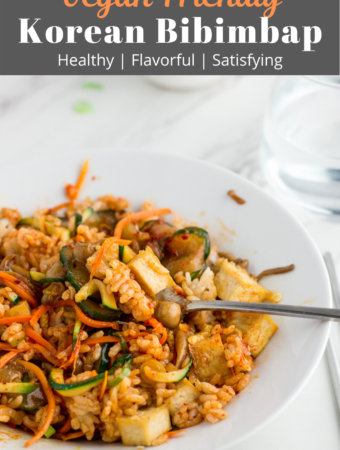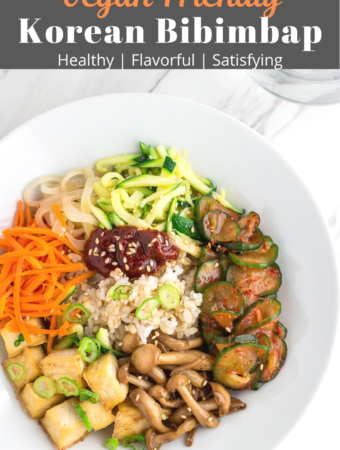Vegan Friendly Korean Bibimbap
How to make Korean Vegan Bibimbap - Rice with tons of veggies topped with sweet and spicy Gochujang sauce equals a healthy tasty meal!
- Prep Time: 15 minutes
- Cook Time: 20 minutes
- Total Time: 35 minutes
- Yield: 4 servings 1x
- Category: Main course
- Method: Stir fried
- Cuisine: Korean
- Diet: Vegan
Ingredients
Scale
For the Sauce
- 3 tablespoons Gochujang (Korean fermented red pepper paste)
- 1 tablespoon mirin (Japanese cooking wine, different from sake)
- 1 tablespoon agave nectar (or sugar)
- 1/2 tablespoon sesame oil
For Bibimbap
- 2/3 of English cucumber (or 2 Persian cucumbers), thinly sliced
- Salt for seasoning
- 6 ounces bean sprouts
- 4 teaspoons vegetable oil
- 1/2 large onion, thinly sliced
- 1 small zucchini, cut into match stick
- 1 medium-size carrot, cut into match stick
- 1 package of mushroom of choice (I used Bunnapi mushroom but any types of mushrooms works)
- 1 tablespoon soy sauce
- 4 teaspoons sugar
- 2 teaspoons sesame oil
- 1/2 teaspoon garlic powder
- 2 teaspoons Korean red pepper flakes (Gochugaru)
- 1 green onion, thinly sliced
- 1 cup of baked tofu (optional)
- Sesame seeds (garnish)
- 3 to 4 cup of cooked rice (short grain, sushi rice)
Instructions
-
- Make the sauce - In a small bowl, mix all ingredients for the sauce and set it aside.
- Cucumber Kimchi - In a colander, add the cucumber slice and sprinkle about 1 teaspoon of salt on top of them. Toss them together and let the salting process begin.
- Bean sprouts - In a medium pot, boil water for blenching bean sprouts. Once the water comes to a boil, add the bean sprouts and cook for 60-90 seconds. Drain and squeeze out as much water as possible. Transfer the blanched bean sprouts to a bowl and season with salt, 1 teaspoon sesame oil, and thinly sliced green onion. Mix until all the bean sprouts are seasoned. Set them aside.
- Onion - In a medium non-stick skillet, add about 1 teaspoon of vegetable oil and sauté the onion. Cook until the onion is translucent. Season with salt (about a pinch). Take them out of the pan and set them aside.
- Zucchini - In the same pan, add about 1 teaspoon of vegetable oil and add zucchini. Cook until zucchini is cooked yet firm, about 2 minutes. Season with salt (about a pinch). Take them out of the pan and set them aside.
- Carrot - In the same pan, add about 1 teaspoon of vegetable oil and add the carrot. Cook the carrot for about 2-3 minutes. Season with salt and set them aside.
- Bulgogi mushroom - In the same pan, add about 1 teaspoon of vegetable oil and add the mushroom. Cook the mushroom until they release water and add 1 tablespoon soy sauce, 2 teaspoons sugar, 1/2 teaspoon garlic powder, and 1 teaspoon of sesame oil. Cook with frequent stirring for about 2 minutes and set them aside.
- Cucumber Kimchi - Make cucumber kimchi. Squeeze all the water out of the cucumber and transfer to a small bowl. Sprinkle 2 teaspoons of Korean red pepper flakes and 2 teaspoons sugar. Taste to see if it needs more salt. Once it is seasoned, set them aside.
- Assemble bibimbap - In a large bowl, add about 1/2 cup to 1 cup of cooked rice on the bottom. Add all the cooked vegetables and baked tofu (if using) on top of the rice. Add a small amount of sauce on top. Mix all the veggies and the sauce with the rice. Taste and adjust the amount of the sauce and enjoy.
Notes
- Please refer to the "Helpful tips on making Korean Vegan Bibimbap" section above.
- Feel free to add and omit any ingredients that don't appeal to you. This is just an example of how I make my Korean vegan bibimbap.
Find it online: https://www.myeclecticbites.com/vegan-friendly-korean-bibimbap/


